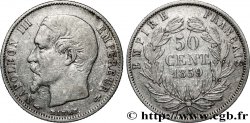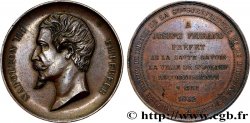fme_774618 - SECOND EMPIRE Coffret des médailles commémoratives offerte à leurs majestés par la Compagnie du Palais de l’Industrie
Not available.
Item sold on our e-shop (2024)
Price : 4 000.00 €
Item sold on our e-shop (2024)
Price : 4 000.00 €
Type : Coffret des médailles commémoratives offerte à leurs majestés par la Compagnie du Palais de l’Industrie
Date: 1855
Metal : copper
Diameter : 68 mm
Orientation dies : 12 h.
Engraver CAQUÉ Armand Auguste (1795-1881) / WIENER Jacques (1813-)
Weight : 1596 g.
Edge : lisse + main CUIVRE
Puncheon : main indicatrice (1845-1860) et CUIVRE
Coments on the condition:
Chaque médaille présente une belle patine marron et quelques traces de manipulation. Très peu d’usure dans l’ensemble. Le coffret est complet mais le dos de la boîte est abîmée (fêlure)
Obverse
Obverse legend : (DIVERSES LÉGENDES).
Obverse description : (divers avers).
Reverse
Reverse legend : (DIVERSES LÉGENDES).
Reverse description : (divers revers).
Commentary
Coffret de 8 médailles en cuivre, en cuir rouge où sont inscrits en lettres dorées (affadis) COLLECTION / DES MEDAILLES COMMEMORATIVES / OFFERTES / A LEURS MAJESTES / PAR LA COMPAGNIE DU PALAIS DE L’INDUSTRIE. Voici le détail :
(poids total avec le coffret : 1596g)
- Médaille, Exposition universelle, La France couronne l’art et l’industrie. avers : napoléon III - empereur. Tête laurée de Napoléon III à gauche; signé : E. A. OUDINE
Revers : exposition universelle // LA FRANCE COURONNE / L’ART ET L’INDUSTRIE. Femme debout, drapée à l’antique, radiée, tend à bout de bras des couronnes de laurier et d’étoiles au dessus de deux femmes assises sur les marches d’un podium, drapées à l’antique. Au centre, un aigle tenant un foudre dans une couronne de laurier. Signé : CAQUE. F. / GRAVEUR DE S. M. L’EMPEREUR. Poids : 153,56G. Diamètre : 68 mm
- Médaille, Napoléon III, Palais de l’Industrie.
Avers : NAPOLEON III - EMPEREUR, tête laurée de profil à gauche, signé : E. A. OUDINE
Revers : PALAIS DE L’INDUSTRIE // à l’exergue : Commencé 10 fév 1853. achevé avril 1855 / napoléon iii empereur / A. Fould, Magne / Ministres. / Vte de rouville directeur / ardoin, ricardo, bouissin, adminrs /
viel archit. barrault Ingr / gervais et cie. EDit. vue sur le palais. Poids : 157,91g, Diamètre : 68 mm. Tranche lisse + poinçon main indicatrice CUIVRE
- Médaille, Bâtiments de l’Exposition universelle
Avers : PALAIS DE L’INDUSTRIE, (légende supérieure) ; PAVILLON DU NORD / GERVAIS ET C EDIT. Vue du Pavillon nord du Palais de l’Industrie; signé : J. WIENER F.
Revers : PALAIS DE L’INDUSTRIE / VUE DES GALERIES / GERVAIS ET CIE EDIT. Vue intérieure des galeries; signé : JACQUES WIENER FEC. et MANGUIN DEL.
Poids : 131,65g ; Diamètre : 67,5 mm. Tranche lisse sans poinçon.
- Médaille, Napoléon III et Eugénie, Palais de l’Industrie, vue des galeries.
Avers : EUGENIE IMPERATRICE - NAPOLEON III EMPEREUR, Têtes d’Eugénie et de Napoléon III à gauche. Signé : CAQUE F. / GRAVEUR DE S. M. L’EMPEREUR
Revers : PALAIS DE L’INDUSTRIE // PAVILLON DU NORD. Vue du Palais de l’Industrie, façade Nord. Signé : GERVAIS ET C EDIT.
Poids : 166,10g Diamètre : 68 mm. Tranche lisse + main CUIVRE
- Médaille, Palais de l’Industrie, Vue des galeries
Avers : PALAIS DE L’INDUSTRIE // à l’exergue : COMMENCÉ FÉVRIER 1853. ACHEVÉ AVRIL 1855 / NAPOLÉON III EMPEREUR / A. FOULD. MAGNE. MINISTRES / Vème DE ROUVILLE DIRECTEUR / ARDOIN, RICARDO, BOUSSIN, ADMINIST / VIEL ARCHIT: BARRAULT ING / YORK, GOLDSMITH CONSTR: / GERVAIS ET CIE EDIT. Vue axonométrique sur le Palais de l’industrie. Signé : WIENER
Revers : PALAIS DE L’INDUSTRIE / VUE DES GALERIES / GERVAIS ET CIE EDIT. Vue intérieure des galeries; signé : JACQUES WIENER FEC. et MANGUIN DEL
Poids : 128,67g ; Diamètre : 67,5 mm. Tranche lisse sans poinçon
- Médaille, Palais de l’Industrie, Vue des galeries
Avers : PALAIS DE L’INDUSTRIE // à l’exergue : COMMENCÉ FÉVRIER 1853. ACHEVÉ AVRIL 1855 / NAPOLÉON III EMPEREUR / A. FOULD. MAGNE. MINISTRES / Vème DE ROUVILLE DIRECTEUR / ARDOIN, RICARDO, BOUSSIN, ADMINIST / VIEL ARCHIT: BARRAULT ING / YORK, GOLDSMITH CONSTR: / GERVAIS ET CIE EDIT. Vue axonométrique sur le Palais de l’industrie. Signé : WIENER
Revers : PALAIS DE L’INDUSTRIE / VUE DES GALERIES / GERVAIS ET CIE EDIT. Vue intérieure des galeries; signé : JACQUES WIENER FEC. et MANGUIN DEL
Poids : 126,54g ; Diamètre : 67,5 mm. Tranche lisse sans poinçon
- Médaille, Prince Jérôme Napoléon, Commission impériale de l’exposition universelle
Avers : S. A. I. LE PRINCE NAPOLEON PRESIDENT DE LA COMMISS.ON IMP.LE. Tête de profil à gauche, signé : ALBERT BARRE
Revers : COMMISSION IMPERIALE / DE L’EXPOSITION UNIVERSELLE / - / S. A. I. LE PRINCE NAPOLEON PRESIDENT / - / (noms des membres de la commission) / - / COMMISSAIRE GENERAL / GENERAL A. MORIN DE L’INSTITUT / DIR. TEUR DU G.OIRE DES ARTS ET METIERS / - / 1855. Légende sur 21 lignes. Signé : GERVAIS - & C.O EDIT
Poids : 162,44g ; Diamètre : 67,5 mm. Tranche lisse + main CUIVRE
- Médaille, Prince Jérôme Napoléon, Commission impériale de l’exposition universelle
Avers : S. A. I. LE PRINCE NAPOLEON PRESIDENT DE LA COMMISS.ON IMP.LE. Tête de profil à gauche, signé : ALBERT BARRE
Revers : COMMISSION IMPERIALE / DE L’EXPOSITION UNIVERSELLE / - / S. A. I. LE PRINCE NAPOLEON PRESIDENT / - / (noms des membres de la commission) / - / COMMISSAIRE GENERAL / GENERAL A. MORIN DE L’INSTITUT / DIR. TEUR DU G.OIRE DES ARTS ET METIERS / - / 1855. Légende sur 21 lignes. Signé : GERVAIS - & C.O EDIT
Poids : 161,18g ; Diamètre : 67,5 mm. Tranche lisse + main CUIVRE.
(poids total avec le coffret : 1596g)
- Médaille, Exposition universelle, La France couronne l’art et l’industrie. avers : napoléon III - empereur. Tête laurée de Napoléon III à gauche; signé : E. A. OUDINE
Revers : exposition universelle // LA FRANCE COURONNE / L’ART ET L’INDUSTRIE. Femme debout, drapée à l’antique, radiée, tend à bout de bras des couronnes de laurier et d’étoiles au dessus de deux femmes assises sur les marches d’un podium, drapées à l’antique. Au centre, un aigle tenant un foudre dans une couronne de laurier. Signé : CAQUE. F. / GRAVEUR DE S. M. L’EMPEREUR. Poids : 153,56G. Diamètre : 68 mm
- Médaille, Napoléon III, Palais de l’Industrie.
Avers : NAPOLEON III - EMPEREUR, tête laurée de profil à gauche, signé : E. A. OUDINE
Revers : PALAIS DE L’INDUSTRIE // à l’exergue : Commencé 10 fév 1853. achevé avril 1855 / napoléon iii empereur / A. Fould, Magne / Ministres. / Vte de rouville directeur / ardoin, ricardo, bouissin, adminrs /
viel archit. barrault Ingr / gervais et cie. EDit. vue sur le palais. Poids : 157,91g, Diamètre : 68 mm. Tranche lisse + poinçon main indicatrice CUIVRE
- Médaille, Bâtiments de l’Exposition universelle
Avers : PALAIS DE L’INDUSTRIE, (légende supérieure) ; PAVILLON DU NORD / GERVAIS ET C EDIT. Vue du Pavillon nord du Palais de l’Industrie; signé : J. WIENER F.
Revers : PALAIS DE L’INDUSTRIE / VUE DES GALERIES / GERVAIS ET CIE EDIT. Vue intérieure des galeries; signé : JACQUES WIENER FEC. et MANGUIN DEL.
Poids : 131,65g ; Diamètre : 67,5 mm. Tranche lisse sans poinçon.
- Médaille, Napoléon III et Eugénie, Palais de l’Industrie, vue des galeries.
Avers : EUGENIE IMPERATRICE - NAPOLEON III EMPEREUR, Têtes d’Eugénie et de Napoléon III à gauche. Signé : CAQUE F. / GRAVEUR DE S. M. L’EMPEREUR
Revers : PALAIS DE L’INDUSTRIE // PAVILLON DU NORD. Vue du Palais de l’Industrie, façade Nord. Signé : GERVAIS ET C EDIT.
Poids : 166,10g Diamètre : 68 mm. Tranche lisse + main CUIVRE
- Médaille, Palais de l’Industrie, Vue des galeries
Avers : PALAIS DE L’INDUSTRIE // à l’exergue : COMMENCÉ FÉVRIER 1853. ACHEVÉ AVRIL 1855 / NAPOLÉON III EMPEREUR / A. FOULD. MAGNE. MINISTRES / Vème DE ROUVILLE DIRECTEUR / ARDOIN, RICARDO, BOUSSIN, ADMINIST / VIEL ARCHIT: BARRAULT ING / YORK, GOLDSMITH CONSTR: / GERVAIS ET CIE EDIT. Vue axonométrique sur le Palais de l’industrie. Signé : WIENER
Revers : PALAIS DE L’INDUSTRIE / VUE DES GALERIES / GERVAIS ET CIE EDIT. Vue intérieure des galeries; signé : JACQUES WIENER FEC. et MANGUIN DEL
Poids : 128,67g ; Diamètre : 67,5 mm. Tranche lisse sans poinçon
- Médaille, Palais de l’Industrie, Vue des galeries
Avers : PALAIS DE L’INDUSTRIE // à l’exergue : COMMENCÉ FÉVRIER 1853. ACHEVÉ AVRIL 1855 / NAPOLÉON III EMPEREUR / A. FOULD. MAGNE. MINISTRES / Vème DE ROUVILLE DIRECTEUR / ARDOIN, RICARDO, BOUSSIN, ADMINIST / VIEL ARCHIT: BARRAULT ING / YORK, GOLDSMITH CONSTR: / GERVAIS ET CIE EDIT. Vue axonométrique sur le Palais de l’industrie. Signé : WIENER
Revers : PALAIS DE L’INDUSTRIE / VUE DES GALERIES / GERVAIS ET CIE EDIT. Vue intérieure des galeries; signé : JACQUES WIENER FEC. et MANGUIN DEL
Poids : 126,54g ; Diamètre : 67,5 mm. Tranche lisse sans poinçon
- Médaille, Prince Jérôme Napoléon, Commission impériale de l’exposition universelle
Avers : S. A. I. LE PRINCE NAPOLEON PRESIDENT DE LA COMMISS.ON IMP.LE. Tête de profil à gauche, signé : ALBERT BARRE
Revers : COMMISSION IMPERIALE / DE L’EXPOSITION UNIVERSELLE / - / S. A. I. LE PRINCE NAPOLEON PRESIDENT / - / (noms des membres de la commission) / - / COMMISSAIRE GENERAL / GENERAL A. MORIN DE L’INSTITUT / DIR. TEUR DU G.OIRE DES ARTS ET METIERS / - / 1855. Légende sur 21 lignes. Signé : GERVAIS - & C.O EDIT
Poids : 162,44g ; Diamètre : 67,5 mm. Tranche lisse + main CUIVRE
- Médaille, Prince Jérôme Napoléon, Commission impériale de l’exposition universelle
Avers : S. A. I. LE PRINCE NAPOLEON PRESIDENT DE LA COMMISS.ON IMP.LE. Tête de profil à gauche, signé : ALBERT BARRE
Revers : COMMISSION IMPERIALE / DE L’EXPOSITION UNIVERSELLE / - / S. A. I. LE PRINCE NAPOLEON PRESIDENT / - / (noms des membres de la commission) / - / COMMISSAIRE GENERAL / GENERAL A. MORIN DE L’INSTITUT / DIR. TEUR DU G.OIRE DES ARTS ET METIERS / - / 1855. Légende sur 21 lignes. Signé : GERVAIS - & C.O EDIT
Poids : 161,18g ; Diamètre : 67,5 mm. Tranche lisse + main CUIVRE.








 Report a mistake
Report a mistake Print the page
Print the page Share my selection
Share my selection Ask a question
Ask a question Consign / sell
Consign / sell
 Full data
Full data









